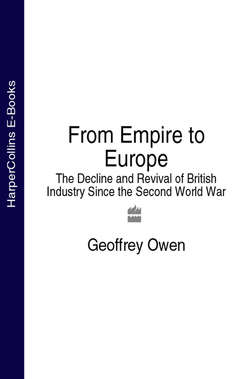Читать книгу From Empire to Europe: The Decline and Revival of British Industry Since the Second World War - Geoffrey Owen - Страница 13
THREE Britain, Germany and France after the Second World War
ОглавлениеWhere did Britain go wrong after 1945? This question began to exercise the minds of politicians and economists at the end of the 1950s as they compared Britain’s relatively sluggish rate of growth with the spectacular performance of Germany, France and Italy. Many people felt that British industry, whether through its own mistakes or those of governments, had thrown away its opportunities at the end of the war. With their manufacturing capacity largely intact, British firms seemed to be in a strong position to make permanent gains in world markets at the expense of their pre-war competitors. Yet it was Germany, not Britain, which had an ‘economic miracle’, based on an extraordinarily rapid increase in exports. At the same time France and Italy, which had been laggards before the war, made a greap leap forward. By 1960 these three countries were threatening to overtake Britain and in some industries had already done so.
By historic standards the British economy performed well during this period. In common with the rest of Western Europe, Britain benefited from a world economic climate which was far more benign than in the 1920s and 1930s. Thanks to the leadership of the US, now converted to the virtues of free trade, the pre-war system of cartels and protection was dismantled, paving the way for a golden age of economic growth which helped all the European nations raise their productivity and their living standards closer to the US level. The British people, as the Prime Minister, Harold Macmillan, remarked in 1957, had ‘never had it so good’.1 Yet the Continental countries did even better, and it was this disparity which gave rise to a growing sense of national failure, reflected in books such as Michael Shanks’ The Stagnant Society. The backwardness of much of British industry, Shanks wrote in 1961, ‘is becoming almost a music-hall joke’.2
A large part of the divergence with the Continental countries – and this was often overlooked in the general gloom about Britain’s deficiencies – was due to two factors over which neither British governments nor British companies had any control.3 First, the Continental countries had suffered more extensive damage during the war, and so were starting from a lower base. It was inevitable that once the damage had been repaired and rational economic policies introduced, they would enjoy some years of exceptionally rapid recovery. Most of the destruction had been to transport and communications rather than to factories. This was particularly true of West Germany, where new investment in plant and machinery during the war had exceeded losses from bombing and demolition.4
Second, Germany and France had larger agricultural sectors than Britain. As economic growth gathered pace in the 1950s, they could transfer labour from low-productivity farming into high-productivity industry, a transition which Britain had gone through many years before.5 In 1950 only 6 per cent of the British labour force was engaged in agriculture, compared with 28 per cent in France and 24 per cent in Germany. Whereas Britain was faced with labour shortages in the first decade after the war, the two Continental countries had a pool of surplus labour on which to draw. In Germany the pool was enlarged by refugees from Soviet-controlled East Germany, many of whom had useful skills and were strongly motivated to contribute to the revival of the country.
TABLE 3.1 Shares of world exports of manufactures 1929–73
Yet these two factors on their own are not enough to explain how the Continental countries converted post-war reconstruction into a period of sustained economic growth which lasted until the early 1970s. By 1973, as TABLE 3.1 shows (previous page), Germany’s share of world exports of manufactures was more than twice as large as Britain’s. This was not a continuation of pre-war trends. Something had changed to give the Continental countries a lift which was missing in Britain. As a first step towards exploring what had changed, this chapter considers the differences between Britain, Germany and France in the aftermath of the war, and the policy choices which were made in the three countries at that time.
